
Abraham "Bram" Stoker was an Irish author who is best known for writing the 1897 Gothic horror novel Dracula. During his lifetime, he was better known as the personal assistant of actor Sir Henry Irving and business manager of the West End's Lyceum Theatre, which Irving owned.
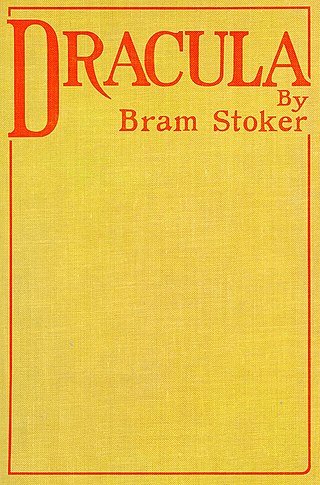
Dracula is a gothic horror novel by Bram Stoker, published on 26 May 1897. An epistolary novel, the narrative is related through letters, diary entries, and newspaper articles. It has no single protagonist and opens with solicitor Jonathan Harker taking a business trip to stay at the castle of a Transylvanian nobleman, Count Dracula. Harker escapes the castle after discovering that Dracula is a vampire, and the Count moves to England and plagues the seaside town of Whitby. A small group, led by Abraham Van Helsing, investigate, hunt and kill Dracula.

Horror is a genre of speculative fiction that is intended to disturb, frighten, or scare. Horror is often divided into the sub-genres of psychological horror and supernatural horror, which are in the realm of speculative fiction. Literary historian J. A. Cuddon, in 1984, defined the horror story as "a piece of fiction in prose of variable length ... which shocks, or even frightens the reader, or perhaps induces a feeling of repulsion or loathing". Horror intends to create an eerie and frightening atmosphere for the reader. Often the central menace of a work of horror fiction can be interpreted as a metaphor for larger fears of a society.

Vampire literature covers the spectrum of literary work concerned principally with the subject of vampires. The literary vampire first appeared in 18th-century poetry, before becoming one of the stock figures of gothic fiction with the publication of Polidori's The Vampyre (1819), which was inspired by the life and legend of Lord Byron. Later influential works include the penny dreadful Varney the Vampire (1847); Sheridan Le Fanu's tale of a lesbian vampire, Carmilla (1872), and the most well known: Bram Stoker's Dracula (1897). Some authors created a more "sympathetic vampire", with Varney being the first, and more recent examples such as Moto Hagio's series The Poe Clan (1972–1976) and Anne Rice's novel Interview with the Vampire (1976) proving influential.
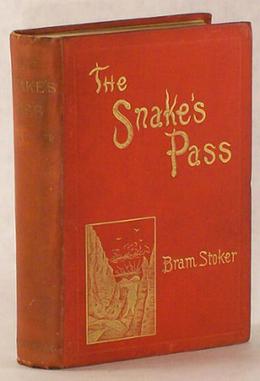
The Snake's Pass is an 1890 novel by Bram Stoker. It centers on the legend of Saint Patrick defeating the King of the Snakes in Ireland, as well as on the troubled romance between the main character and a local peasant girl. The Snake's Pass was Stoker's second imperial fiction novel, and was first published in the United Kingdom in 1890. The novel is a precursor to Stoker's Dracula.

The Jewel of Seven Stars is a horror novel by Irish writer Bram Stoker, first published by Heinemann in 1903. The story is a first-person narrative of a young man pulled into an archaeologist's plot to revive Queen Tera, an ancient Egyptian mummy. It explores common fin de siècle themes such as imperialism, the rise of the New Woman and feminism, and societal progress.
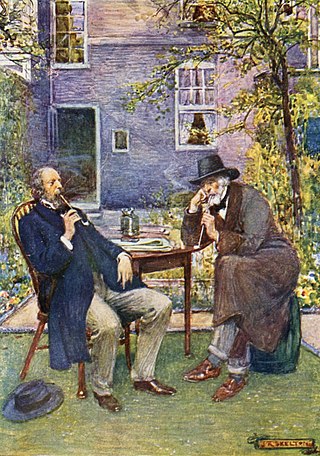
Victorian literature is English literature during the reign of Queen Victoria (1837–1901). The 19th century is considered by some the Golden Age of English Literature, especially for British novels. In the Victorian era, the novel became the leading literary genre in English. English writing from this era reflects the major transformations in most aspects of English life, from scientific, economic, and technological advances to changes in class structures and the role of religion in society. The number of new novels published each year increased from 100 at the start of the period to 1000 by the end of it. Famous novelists from this period include Charles Dickens, William Makepeace Thackeray, the three Brontë sisters, Elizabeth Gaskell, George Eliot, Thomas Hardy, and Rudyard Kipling.
Lucy Westenra is a fictional character in the 1897 novel Dracula by Bram Stoker. The 19-year-old daughter of a wealthy family, she is Mina Murray's best friend. Early in the story, Lucy gets proposed to by three suitors, Arthur Holmwood, John Seward, and Quincey Morris, on the same day. Turning the latter two down due to already being in love with Arthur, she accepts his proposal. Before getting the chance to marry, Lucy becomes Count Dracula's first English victim, and despite Seward contacting Abraham Van Helsing for help, she transforms into a vampire. Following her return as a vampire and attacks on children—dubbed the "Bloofer Lady" by them—she is eventually cornered into her crypt by Van Helsing and her suitors who destroy her, putting her soul to rest.
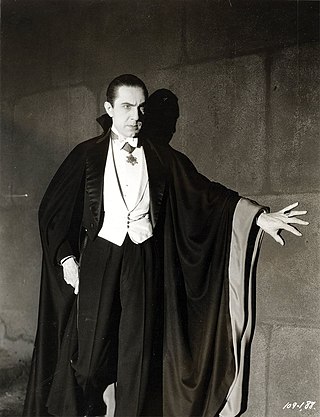
Count Dracula is the title character of Bram Stoker's 1897 gothic horror novel Dracula. He is considered the prototypical and archetypal vampire in subsequent works of fiction. Aspects of the character are believed by some to have been inspired by the 15th-century Wallachian prince Vlad the Impaler, who was also known as Vlad Dracula, and by Sir Henry Irving, an actor for whom Stoker was a personal assistant.

Dracula, also known as Bram Stoker's Dracula and Dan Curtis' Dracula, is a 1974 British made-for-television gothic horror film and adaptation of Bram Stoker's 1897 novel Dracula. It was written by Richard Matheson and directed by Dark Shadows creator Dan Curtis, with Jack Palance in the title role. It was the second collaboration for Curtis and Palance after the 1968 TV film The Strange Case of Dr. Jekyll and Mr. Hyde.
Melion is an anonymous Breton lai that tells the story of a knight who transforms into a werewolf for the love of his wife who betrays him.

English literature is literature written in the English language from the English-speaking world. The English language has developed over more than 1,400 years. The earliest forms of English, a set of Anglo-Frisian dialects brought to Great Britain by Anglo-Saxon invaders in the fifth century, are called Old English. Beowulf is the most famous work in Old English. Despite being set in Scandinavia, it has achieved national epic status in England. However, following the Norman conquest of England in 1066, the written form of the Anglo-Saxon language became less common. Under the influence of the new aristocracy, French became the standard language of courts, parliament, and polite society. The English spoken after the Normans came is known as Middle English. This form of English lasted until the 1470s, when the Chancery Standard, a London-based form of English, became widespread. Geoffrey Chaucer (1343–1400), author of The Canterbury Tales, was a significant figure developing the legitimacy of vernacular Middle English at a time when the dominant literary languages in England were still French and Latin. The invention of the printing press by Johannes Gutenberg in 1439 also helped to standardise the language, as did the King James Bible (1611), and the Great Vowel Shift.

The Mystery of the Sea is a mystery novel by Bram Stoker, first published in 1902. It tells the story of an Englishman living in Aberdeenshire, Scotland, who meets and falls in love with an American heiress. She is involved with the intrigues of the Spanish–American War, and a complex plot involving second sight, kidnapping, and secret codes unfolds over the course of the novel.

Lady Athlyne is a romance novel by Bram Stoker, written in 1908. It was published one year before the release of Stoker's The Lady of the Shroud.

Sarah Grace Perry is an English author. She has had four novels published: After Me Comes the Flood (2014), The Essex Serpent (2016), Melmoth (2018) and Enlightenment (2024). Her work has been translated into 22 languages. She was appointed Chancellor of the University of Essex in July 2023, officially starting in this role on 1 August 2023.
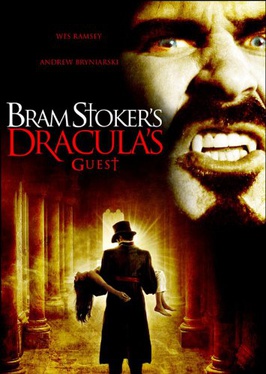
Bram Stoker's Dracula's Guest is a 2008 film that was written and directed by Michael Feifer. It was released direct to video in August 2008 and is loosely based on Bram Stoker's short story "Dracula's Guest".

Mummies are commonly featured in horror genres as undead creatures wrapped in bandages. Similar undead include skeletons and zombies.
Bibliography of works on Dracula is a listing of non-fiction literary works about the book Dracula or derivative works about its titular vampire Count Dracula.

The Blood of the Vampire is a Gothic novel by Florence Marryat, published in 1897. The protagonist, Harriet Brandt, is a mixed-race psychic vampire who kills unintentionally. The novel follows Harriet after she leaves a Jamaican convent for Europe, and her ill-fated attempts to integrate with Victorian society.
Irish Gothic literature developed in the eighteenth and nineteenth centuries. Most of the writers were Anglo-Irish. The period from 1691 to 1800 was marked by the dominance of the Protestant Ascendancy, Anglo-Irish families of the Church of Ireland who controlled most of the land. The Irish Parliament, which was almost exclusively Protestant in composition, passed the Penal Laws, effectively disenfranchising the Catholic majority both politically and economically. This began to change with the Acts of Union 1800 and the concomitant abolition of the Irish Parliament. Following a vigorous campaign led by Irish lawyer Daniel O'Connell, Westminster passed the Roman Catholic Relief Act 1829 removing most of the disabilities imposed upon Catholics.
















